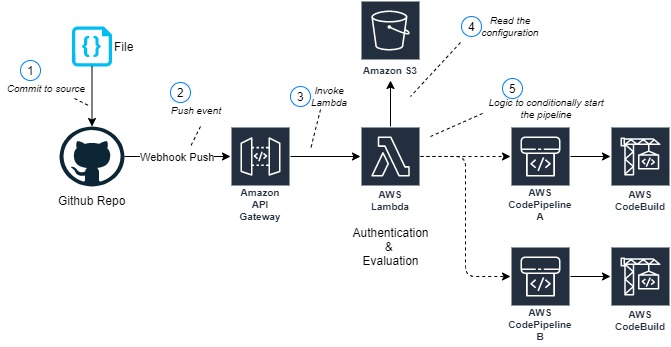AWS DevOps Blog
Tag: CI/CD
Blue/Green deployment with AWS Developer tools on Amazon EC2 using Amazon EFS to host application source code
Many organizations building modern applications require a shared and persistent storage layer for hosting and deploying data-intensive enterprise applications, such as content management systems, media and entertainment, distributed applications like machine learning training, etc. These applications demand a centralized file share that scales to petabytes without disrupting running applications and remains concurrently accessible from potentially […]
Enforcing AWS CloudFormation scanning in CI/CD Pipelines at scale using Trend Micro Cloud One Conformity
Integrating AWS CloudFormation template scanning into CI/CD pipelines is a great way to catch security infringements before application deployment. However, implementing and enforcing this in a multi team, multi account environment can present some challenges, especially when the scanning tools used require external API access. This blog will discuss those challenges and offer a solution […]
Building a CI/CD pipeline to update an AWS CloudFormation StackSets
AWS CloudFormation StackSets can extend the functionality of CloudFormation Stacks by enabling you to create, update, or delete one or more stack across multiple accounts. As a developer working in a large enterprise or for a group that supports multiple AWS accounts, you may often find yourself challenged with updating AWS CloudFormation StackSets. If you’re […]
Building an end-to-end Kubernetes-based DevSecOps software factory on AWS
DevSecOps software factory implementation can significantly vary depending on the application, infrastructure, architecture, and the services and tools used. In a previous post, I provided an end-to-end DevSecOps pipeline for a three-tier web application deployed with AWS Elastic Beanstalk. The pipeline used cloud-native services along with a few open-source security tools. This solution is similar, […]
Choosing a CI/CD approach: AWS Services with BigHat Biosciences
Founded in 2019, BigHat Biosciences’ mission is to improve human health by reimagining antibody discovery and engineering to create better antibodies faster. Their integrated computational + experimental approach speeds up antibody design and discovery by combining high-speed molecular characterization with machine learning technologies to guide the search for better antibodies. They apply these design capabilities […]
Choosing a Well-Architected CI/CD approach: Open-source software and AWS Services
Take a Well-Architected approach to make an informed decision when choosing to implement CI/CD using open-source tools on AWS services, using managed AWS services, or a combination of both.
We will look at key considerations for evaluating open-source software and AWS Services using the perspectives of a startup company, and a mature company, as examples. These will give you two very different points of view that you can use to compare to your own organization. To make this investigation easier we will use Continuous Integration (CI) and Continuous Delivery (CD) capabilities as the target of our investigation.
In our next two blog posts we will follow two AWS customers Iponweb and BigHat Biosciences as they share their CI/CD journeys, their perspective, the decisions they made, and why.
To end the series, we will explore an example reference architecture showing the benefits AWS provides regardless of your emphasis on open source tools or managed AWS services.
Continuous Compliance Workflow for Infrastructure as Code: Part 1
Security and compliance standards are of paramount importance for organizations in many industries. There is a growing need to seamlessly integrate these standards in an application release cycle. From a DevOps standpoint, an application can be subject to these standards during two phases: Pre-deployment – Standards are enforced in an application deployment pipeline prior to […]
Choosing a CI/CD approach: Open Source on AWS, an Iponweb story
Iponweb is a global leader in building programmatic and real-time advertising technology and infrastructure for some of the world’s biggest digital media buyers and sellers. The company develops client-facing products and internal development tools that must be platform agnostic to support spanning across multiple cloud services. In this post, we explore how Iponweb applied key […]
Integrate GitHub monorepo with AWS CodePipeline to run project-specific CI/CD pipelines
Understand how to automate trigger of project specific code pipeline for GitHub mono repos users. Currently, if a customer is using GitHub as a version control system and he has only one repository which contains multiple folders each for a different project, change in any file, triggers the code pipeline for the whole repository rather than for the appropriate project. With this blog, they would be able to automate trigger of appropriate pipeline based on the project folder where the file gets changed.
Best practices for developing cloud applications with AWS CDK
April 20, 2022: Updates are available in the Best practices topic of the AWS CDK documentation. The documentation is the most up-to-date resource going forward. In this post, we discuss strategies for organizing the development of complex cloud applications with large teams, using the AWS Cloud Development Kit (AWS CDK) as a central technology. AWS […]









